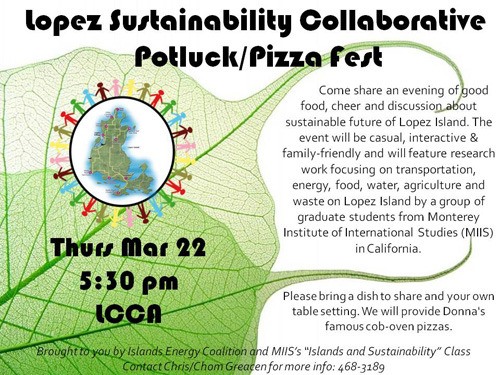By Chom and Chris Greacen
What resources are required to sustain the economy and residents of Lopez Island and what would the future of Lopez look like if we were to continue “the business as usual” versus to become more sustainable? These are the questions that a group of eleven graduate students from the Monterey Institute of International Studies in California is seeking to help our community find answers to.
A few Islands around the world have been in the forefront of humanity’s push for sustainability and lower resource consumption. Islands offer unique opportunities as “petri dishes” for global resource sustainability because boundaries are particularly easy to draw (they’re surrounded by water, after all) and because energy and other resources are typically higher in cost than on the mainland, increasing the relative attractiveness of energy efficiency, renewable energy, and other home-grown options. While the Danish island Samso provides an amazing precedent on the energy front – from heavy dependence on imported coal electricty to 100 percent local renewable energy – there are as yet no populated islands in the USA that have achieved a zero-net energy goal. As Samso discovered, the switch to sustainability created a huge boon to the local economy, as the island is now a mecca for tourists interested in the environment. We don’t mean to imply that Samso should be model for Lopez, but this example does illustrate some of the potential for sustainability working hand-in-hand with a thriving local economy.
The graduate students, taking a class taught by Lopez residents Chris and Chom Greacen, are working together on a hands-on class project focusing on Lopez Island. They will document baseline energy and resource consumption, and explore plausible scenarios for the future. The class has been meeting since early February with classes convened via internet video. Students are split into three groups, with the first focusing on electricity and heating, the second group on transportation, and the third on agriculture, food, water and waste. Their final report, to be completed in June, will be posted online on the Islands Energy Coalition website at http://islandsenergy.wordpress.com/.
The students will be on Lopez from 17 to 22 March gathering data, learning from Lopezians, and discussing initial findings. The class trip will culminate in a “Lopez Sustainability Collaborative and Potluck/pizza Fest” event at the Lopez Center for Community and the Arts on Thursday 22 March from 5:30 – 8 p.m.
The event will be family-friendly and interactive with multiple media and opportunities for all to participate in different ways. Those interested in or curious about our island’s future (or specific issues such as transportation, energy, food/agriculture, waste and materials) — those who simply enjoy good food and good company.
Bring a dish to share and your own table settings. We will provide Donna Hasbrouck’s famous cob-oven pizza.
Check out the evolving blog by the students: http://blogs.miis.edu/resilientcommunities/ or contact Chom or Chris 468-3189 for further info.



